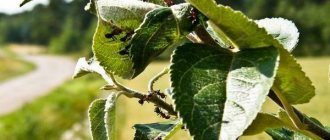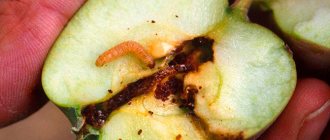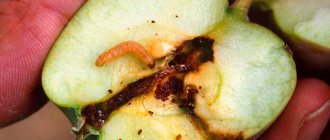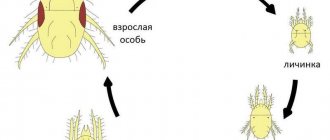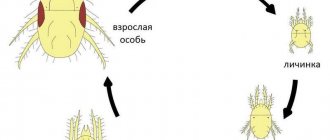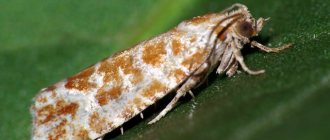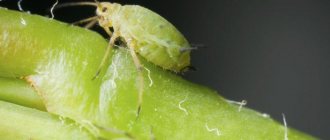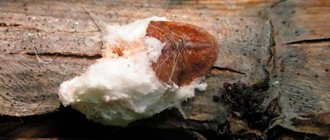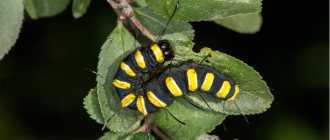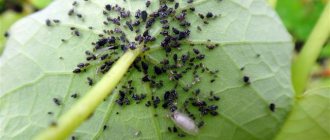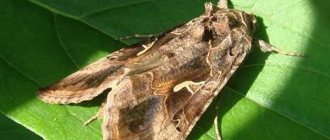Aphids are one of the fastest growing and most annoying insects. In the summer, many trees, including the apple tree, are attacked by these small harmful organisms, which, sucking the juice from the leaves, begin to reproduce massively.
They secrete honeydew, which ants and other insects love. Therefore, attacks on the apple tree continue. From our article you will learn how to fight aphids on an apple tree.
Common types of aphids
The insect is small: its size is no more than 7 mm. This is a representative of the phytophagous family with a proboscis for sucking juice from plant crops. By piercing the cell with a piercing mouthpart, it feeds on its juice.
During the life of aphids, honeydew (decomposition products) , containing many sugary substances. A variety of insects flock to it: flies, bees, wasps. Ants love her very much .
There are different types of aphids, their color depends on the plant they parasitize: light green, dark green, black, gray, orange, light pink. There are a huge number of aphid species. On fruit trees and apple trees live:
- Red-headed or gray aphid;
- Green apple moth;
- Green rose moth.
Its characteristic features:
- The body is 2 mm long, green with white antennae and a red head;
- The overwintering place for eggs is the bark of an apple tree;
- In spring, females hatch from the eggs - the founders of the future colony on this tree;
- Females are capable of hatching up to 50 larvae. They begin to parasitize on the lower part of the leaf blade;
- A second wave of winged females hatch in June, with a black body and green belly;
- The next generation produces a new offspring of winged and wingless individuals of both sexes;
- In September, aphids develop especially actively.
Attention! A colony of ants will help the pest settle on the apple tree. Honeydew (honeydew) is a tasty delicacy for them. Ants guard and protect aphids; they monitor the growth of the colony. Therefore, the fight against aphids on an apple tree also includes the fight against ants .
Settling on different parts of the tree, aphids crawl and fly from place to place. And where it stops “for a while”, the plant begins to have serious problems and you must know how to protect the apple tree from aphids.
Seasonal features
The cycles for treating the garden against aphids depend on the growth phases of the apple tree:
- February-March is characterized by a period of dormant buds. At this time, the trees are treated against pests that survived the winter months.
- April-May is the period when buds open and trees bloom.
- At the end of May-beginning of June, fruit set occurs. At this time, 1-2 treatments are carried out.
- Active fruit growth occurs in June-July. During this period, it is necessary to spray the trees 2-3 times.
- August-September is the fruiting period. If necessary, 1 or 2 disinfections are allowed at this time.
- In October-November, after the harvest and the leaves have fallen, the last spraying of the year is carried out.
Advice! The age of the garden affects the number of treatments needed. For 5-7 years old, 7-8 events are enough, for 8-15 years old - 8-9, and for gardens over 15 years old - 10.
Photo of aphids on an apple tree:
Gray apple aphid.
Roseate green aphid.
Green apple aphid.
Signs of a pest
Understanding which pest has “attacked” your garden is not that difficult.
- Red swellings appear on the leaves;
- The leaves on the apple tree curl, turn black and dry out;
- The shoots stop growing;
- The tops of the apple tree are twisted;
- A sticky honeydew appears on them, onto which the ants crawl.
Honeydew formed during the life of aphids.
The aphids continue to move through the tree. It begins to parasitize on the apical part, so you may not be able to detect it right away. It leaves behind exhausted and weak shoots and leaves. Finding aphids is quite simple: you need to turn over a leaf, and a colony of small green insects will appear in front of you. The presence of ants on an apple tree can also alert you and force you to examine it carefully.
You should know it! Aphids not only parasitize apple trees, they also carry viral infections , which can cause serious damage to cultivated plants. In addition, it causes serious damage to young crops .
So, we found out that there are aphids on the apple tree in your garden - what to do? Fighting aphids is not easy: the reproduction process is fast and constant. To actively kill insects, you can use both folk and traditional preparations and modern chemicals. In addition, there are natural helpers.
Natural allies in the fight against aphids
It would be good if it were not us who had to deal with pests, but their natural enemies . And aphids do have such enemies, so treating apple trees against aphids with chemicals is not always justified.
Insects that eat aphids include: hoverflies, ladybugs, lacewings, earwigs, wasps, ground beetles and other predatory garden inhabitants. To attract them, fragrant herbs are grown in the garden.
The ladybug is a natural enemy of aphids.
Aphids are eaten by small birds or serve as food for chicks. Sparrows, tits, wrens, wrens, and linnets are not averse to eating the pest for lunch. They also need to be attracted to your plot: make birdhouses, put up drinking bowls.
Wren is another assistant in the fight against aphids.
Attention! Treatment with pesticides is prohibited if you use biological methods to control aphids.
There are also plants that contain phytoncides , which repel aphids. These are herbs with a strong aroma :
- Marigold;
- Coriander;
- Garlic;
- Mint;
- Basil;
- Lavender;
- And others.
In small groups they can be placed in the garden area.
How can you spray apple trees against aphids without chemicals? Biological control methods also include special preparations. Biological “medicines” are more environmentally friendly. They contain extracts from plants and herbs.
Most gardeners prefer preparations of this series. Actarin and Actofit help against aphids . They can be used both during flowering and during budding and fruit set, because they will not cause harm.
Prevention
It is better to take preventive measures and prevent aphids from breeding. After all, the struggle will require much more strength, energy, attention and investment. Plants with strong repellent odors are planted next to apple trees. These include:
- coriander;
- tomatoes;
- garlic;
- dill;
- parsley;
- marigold.
In addition to strong-smelling plants, they attract insects to the garden, for which aphids are a favorite food. These are ladybugs, hover flies, lacewings, some types of spiders, and sand wasps. To attract them, it is recommended to plant dill, oregano, marigolds, yarrow, and buckwheat.
IMPORTANT! Regular inspections of trees and young shoots before and after planting are a necessary part of prevention.
You should also monitor the ant population in the area. In autumn, it is recommended to remove old dried leaves and affected areas from trees. Once removed, they are burned.
When apple aphids appear on trees, it is necessary to take urgent measures to destroy them, since very soon all the trees in the area will be infected. The parasitic insect and its larvae will gradually suck all the juices out of the tree and destroy it.
Ants and aphids on an apple tree: how to fight with folk remedies?
Let's start with traditional (folk) methods of struggle, because chemical “medicines” will saturate both apple trees and the ground. And ultimately they will end up (partially) in our bodies. Created on the basis of laundry soap and herbs, such methods are considered the most effective.
| Name of the infusion | Cooking method |
| Tobacco infusion | Use 500 g of tobacco, 30-40 g of laundry soap per 20 liters of water. Tobacco leaves are infused in 10 liters of warm water for 2-3 days. The solution is filtered and the remaining water is added. The laundry soap is crushed and mixed well with the solution. The soap is needed to help the solution stick to the leaves. |
| Yarrow infusion | Take 700-800 g of yarrow, 40 g of laundry soap and 10 liters. water. The grass is poured with boiling water and allowed to stand for several days. Then soap is added and diluted in it. |
| Ash use | Use 3 cups of ash, 40g. laundry soap, 10l. water. Ash and grated soap are diluted in warm water. Let it brew for two days. Using this recipe will not only get rid of aphids, but will also work as foliar feeding. |
| Tomato tops | Take 5 kg of green leaves, add 10 liters. hot water and 30 min. boil. Prepare the solution in the required proportions: 1 liter. decoction – 3l. water. Before use, add soap (30 g of soap per 10 liters of water). |
| Hot pepper | 100g. fresh pods are boiled in 1 liter. water, let it brew for 2 days, filter. The resulting concentrated solution is diluted 1:10. 40g of soap are diluted into 10 liters of water. |
Attention! A 10-liter bucket of infusion is enough to spray 5 fruit trees. Any solution prepared for the first time must first be tested on a small area to ensure its effectiveness. You need to use a fine spray to treat the lower part of the leaf blade.
Infusions from plants, despite their composition, can be dangerous :
- Cause a burn on the leaves (if a high concentration of solution is used);
- Posing a danger not only to the pest, but also to the beneficial inhabitants of the garden;
- Some of them are poisonous to humans.
The method that was used by our grandfathers and great-grandfathers is fumigation with tobacco smoke :
- Take a bucket or large tin and light a fire from the twigs;
- The fire flares up and you need to pour tobacco dust into it;
- You place the container so that the white smoke hits the trees;
- You smoke for several hours;
- When the smoke disappears, the aphids will die.
You should know it! If no control measures are taken, the aphid will produce 50 generations over the summer, causing damage to absolutely healthy crops. Approximately 450 species of leaf aphids are among the most serious agricultural pests.
Mechanical protection methods
For physical traps and baits, trapping belts . To do this, take masking tape and wrap it around the trunk (about half a meter from the ground). A sticky layer of glue against rodents and insects is applied to it around the circumference of the trunk.
Disadvantage: on hot days the glue drips.
a layer of foam rubber around the barrel below the masking tape lubricate its upper part . This method is more reliable. Neither ants nor aphids will be able to climb the trunk.
There are several agricultural techniques on how to save an apple tree from ants and aphids, but they are ineffective :
- Weeding and garden digging;
- Removing aphids from foliage by hand;
- Rinse off with a powerful stream of water.
Preventative measures can also be used. Such, for example, as fighting ants , attracting natural enemies to the site .
Attention! Do not overfeed the tree with nitrogen fertilizers, because it is young greenery that attracts aphids.
Let's try new means!
"Decis Profi"
We decided not to give up and went in search of a new remedy. At the garden store, the salesperson recommended the drug "Decis Profi" to us. The packaging also says that the product effectively fights aphids on apple trees, codling moths, and Colorado potato beetles. Well, let's try! We will certainly share the result in the near future.
